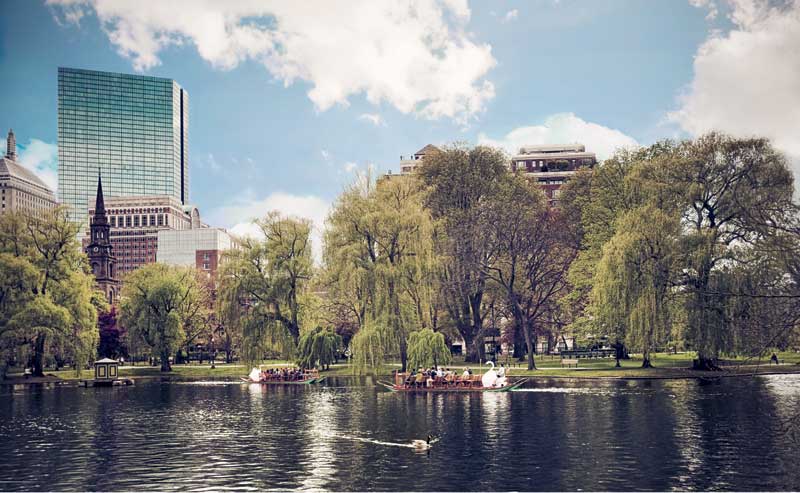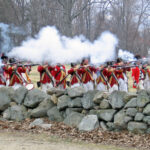Travel: New England Traditions
From swan boats in Boston to sugaring in Vermont, generations of New Englanders know the traditions that mark the change of season.

Coffee By Design | Portland, Maine
Photo Credit : Katherine KeenanMake Way for Swan Boats At the Boston Public Garden, we can all be children.
Crusty Bostonians can be sentimental, too. They hang onto things for generations. That’s what has helped preserve their hometown’s architectural distinctiveness when almost every other city in America looks like Houston.
And one of those things that Bostonians hang onto is the ritual of riding the swan boats–those pretty, pedal-powered throwbacks that seasonally circumnavigate the manmade pond at the center of Boston’s lush and beautiful Public Garden.
People who once rode these icons with their grandparents now take their grandchildren. And kids who live in an age of Xbox like it, primed by the Robert McCloskey classic Make Way for Ducklings and excited by the real-life mallards and swans sharing the lagoon with them.
“We got so close to the ducks that we could see their flippers,” gushes 7-year-old Elisabeth, who’s just gone for a ride with her second-grade class. She saw the lagoon’s two swans, too, she says, but “the swan on the boat was too proud to answer.”
It figures. When Robert Paget designed the first of the swan boats in 1877, laying boards across two rowboats, he was inspired by the Wagner opera Lohengrin, in which a knight in shining armor rides a boat drawn by a swan. So for his own version he had a copper swan made to hide the pedal-powered paddlewheel.
Today there are six boats in service, the granddaddy of the fleet now 93 years old. They’re still driven by pedal power (though the swans are fiberglass). And the fourth and fifth generations of Pagets run the concession, which operates from Patriots’ Day weekend in April till mid-September.
“One of my favorite places to stand is at the exit on the dock,” says Lyn Paget. “People are out there only for 15 minutes, but in that 15 minutes the experience they get is the same experience people have been getting for 135 years.”
She pauses. “There aren’t a lot of things you can completely replicate from your childhood,” she adds. “This is one you can.” –Jon Marcus
A Taste of the Growing Year Flower shows give us our first blast of bloom.
For New England gardeners, flower shows are our sneak previews. We flock to the interiors of convention centers, warehouses, basketball arenas. Outside, the weather’s usually bad; indeed, we prefer it that way. We’ll wade through deep snow if necessary, our tickets already in hand, eager to get inside, ahead of the crowd.
A few feet past the entrance, though, we stop, stunned by a blast of bloom, overwhelmed by this tsunami of green. Add the burble of falling water, the cooing of doves, the scents of lemon blossoms and eucalyptus, rose geranium and damp ground, and we forget that the floor is concrete, the sky a maze of ductwork and spotlights. This is our first taste of the growing year, and it nearly chokes us.
What to look at first? Some turn left, others right; children disappear, to be found only later, happily watching butterflies or koi or Lady Amherst pheasants. There are scores of gardens, and every one, large or small, woodland or patio, vegetable patch or parterre, is perfect. Every leaf is in place; spires of delphinium and foxglove reach for the sky; streams cascade over rocks and magically return to their starting points.
We see it and we want it–that’s the exhibitors’ art. And the vendors’, too. When we’ve examined every rose-covered pergola, each flowering tree, the water lilies and the bonsai, when we’re sure there’s nothing we haven’t seen, or bent to smell, we wander off down the aisles of offerings. We stop and admire a greenhouse the way someone might a luxury sedan at an auto show, but, being New Englanders, we settle for buying a single gardenia blossom the way our fathers always did.
Finally, when our feet tire, we head back toward the door. Pulling on our coats, we step into the slush and drizzle. Some of us have bunches of pussywillows, an orchid, another dahlia. These aren’t souvenirs of the show–they’re our tickets to spring, the one we know now is just around the corner. –Roger B. Swain
The Delicious Time Maple weekends offer a taste of the sweet life.
Sugaring season is fleeting, and sugarmakers, those who rush to the woods to collect sap, know this. When leaf buds sprout, the sap gets bitter. And that’s it. But, for the rest of us, this year’s celebration of liquid gold has just begun. When the sap starts flowing, sugarhouses across New England open their doors to the public, sharing the tradition with young and old alike.
These days are a gift to our senses. White clouds billow from sugarhouse chimneys, dotting the rolling landscape. The air holds a faint scent of sweetness–the kind you pour all over a stack of pancakes–as 40 gallons’ worth of sap gets boiled down to make one gallon of pure maple syrup. The grownups sample the grades (depending on when the sap was collected, it might be fancy, grade A, or grade B), contemplating the nuances of the flavors, while the little ones sneak a couple of extra shots and start running circles around the maple creamie stand. We sample maple in all its different forms–sugar-on-snow, sugar candy, cotton candy, syrup on waffles. Our hands get sticky, just like the little ones’. Maple doesn’t discriminate. And we all smile with delight. Maple makes life more delicious. –Heather Atwell
SplashDown Going wild and woolly at the bottom of the slopes.
It’s pond-skimming day on this late-March afternoon at Sugarbush Resort in Warren, Vermont. It may be 29*, but the sun’s out, and the fans arrive, wearing tutus and togas, bikinis and beads, leis and lace. They’re dressed as hot dogs, pizza slices, and Chinese takeout; lions and tigers, SpongeBob SquarePants, and Elmo; Darth Vader and Captain America. And they’re all wearing skis and snowboards as they slide down the 100-yard in-run at the base and brace themselves for a splash.
Sugarbush’s Lincoln Peak hosts the longest continually running pond skim in the Northeast. Back in 1968, and for many years after, it was held on a real pond, the snowmaking one. Now it’s at a temporary pool of turquoise water, as pretty as any Caribbean sea but nearly as cold as the air: 34°. Making it all the way across requires three parts speed, two parts stability, and one part fat boards underfoot.
That’s not always the point, though: Witness the belly flops, the pirouettes, and the spins. Those who skim successfully pump their fists and mug for the cameras; those who don’t will flounder, panic, and sputter until a ski patroller helps them out of the frigid water with a hook or buoy.
See, the spectacle is the skim, but the real story is not only the hundreds of skiers and riders, but the spectators as well–grandparents, teenagers, Baby Bjoern-wearing moms and dads … The smell of beer and barbeque hangs in the air, and there’s just enough giddiness to inspire some of us to try it next year. –Sarah Tuff
Snow-Bowl Theater You don’t need to ski to take in the thrills, pageantry–and even danger– of Tuckerman Ravine.
On a mild New Hampshire day in late April, I strapped skis onto my pack, as if walking with a teepee over my head, and set off, heading for Mount Washington to ski breathtaking Tuckerman Ravine. Just days earlier, snow and ice were still covering the three-mile trail that climbs toward Tucks from Pinkham Notch, requiring skis and/or crampons to reach the bowl. Half a mile up, the Crystal Cascade sign was enough of an invitation for me to take a short detour to this impressive waterfall and catch my breath.
Then onward. Once I reached Lunch Rocks, a tumble of stone on the right as you enter the ravine, I dropped my pack, slathered on sunscreen, and stretched out, taking in the scene. A few skiers wiped out and slid at impressive speeds till they tumbled to a stop in the patchy grass on the floor of the ravine. Cries of “Ski!” and “Rocks!” and “Ice!” rose above the voices and the music throughout the day. When you hear those words, take cover. Gravity is turned way up at Tucks. Rocks and ice let loose without warning. More than a nuisance, these projectiles can be deadly.
With skis over one shoulder, poles in the other hand, and before I could lose my nerve, I marched forward, digging the toes of my boots into the soft snow, heading up the steep and narrow steps made by skiers who’d gone before me. When the fingers of my outstretched left hand nearly touched the slope, I knew: high enough. Next, the task was to lay my skis down and click into my bindings without tipping over into freefall. I had no fantasy of looking good. I hoped merely to survive. I’d use all the real estate I needed. Nice big traverses.
In my own inelegant way, I got down. I skied over to Lunch Rocks, stepped out of my bindings, and have never stepped into a ski at Tucks again, though I’ve returned many times. The thing is, you don’t have to ski Tucks to love it.
The magic of spring here is so many things: the camaraderie of friends and strangers on the trail; dogs chasing Frisbees; beach balls being batted around; the soulful, funky notes of a saxophone floating on the air. A kind of snow-bowl theater in the round is within reach of anyone who can hike the three miles to the floor of the ravine.
For all of my trips here, I loved the saxophone day most; I listen for those sweet notes every time I round the bend and look into Tucks’ great glacial cirque. –Annie Card
A Place of Wonder for Lovers of Books New England’s oldest and largest book sale turns 50.
In New Hampshire’s Upper Connecticut River Valley, home to the Five-Colleges Book Sale, bibliophiles have long circled one particular April weekend on their calendars. At Lebanon High School, 75,000 books, DVDs, CDs, books on tape, and videos find tables to land on. There are plenty of signs and red-aproned volunteers to direct you to the children’s section, Civil War, CliffsNotes, collectibles, cookbooks–and that’s just the Cs.
All year long, donated books gather in an empty storefront. In 2010, 425 boxes of books were trucked in from a single donor in Newbury, New Hampshire. Another contributor delivered 18 boxes of cookbooks. One memorable “find” was an Edward Gorey pop-up book, appraised at $600. “We count serendipity one of the pleasures of our sale,” says one organizer. Donations are sorted by volunteers, mostly alumnae of the five colleges that benefit from the proceeds: Simmons, Smith, Vassar, Wellesley, and Mt. Holyoke. The sale can yield up to $70,000 in scholarship aid for students from New Hampshire and Vermont.
Shoppers start lining up two hours before the doors open. Hundreds of buyers, many of them dealers looking for specialties, rush in for the first 15 minutes. Our tip? Wait for the midafternoon lull, or for Sunday’s half-price sale. –Barbara Hall
May Breakfasts Sometimes the food is the least important memory.
On or around May 1 here in Rhode Island, from Woonsocket to Westerly, in Elks lodges and high schools, fire stations and church basements, people are eating jonnycakes, clamcakes, and pancakes; bacon, ham, and scrambled
eggs; soufflés and apple pie. It all began in 1867, when the Old Quaker Meeting House in Cranston–by that time hosting a Baptist congregation–first raised money by sponsoring a two-day May celebration like the ones traditionally held in England. Folks sang hymns, ate chicken, danced around a maypole, and raised $155.50–a success.
For me, a century later, May breakfasts meant putting on dressy clothes, piling into our green Chevy station wagon with my parents and brother, and driving to one church or another. We’d go into the basement, take our seats at a long folding table, and eat. And eat. My brother always ate the most. My father always liked it best. My mother always complained (eggs too dry or runny, bacon too fatty or burned). I didn’t know we were doing anything special until I moved away and May came and went without a May breakfast to be had.
When I moved back to Rhode Island in the early ’90s and had kids of my own, I saw a sign one day outside a church: May Breakfast This Saturday. In that moment, I could already smell that church basement. I could already taste the eggs. We didn’t dress fancy, but there were long folding tables and eggs and pancakes and bacon and weak coffee and Dixie cups of orange juice, all of it served by Boy Scouts in their tan-and-green uniforms with their colorful merit badges.
We ate and ate, and then we climbed the stairs and opened the door and stepped outside. Dogwood trees wore pink-and-white blossoms. Tall purple irises bowed as we passed. I paused. I took a deep breath. Spring. That’s what May breakfasts really do: They remind us that winter is over. Spring is here. Anything is possible. –Ann Hood







